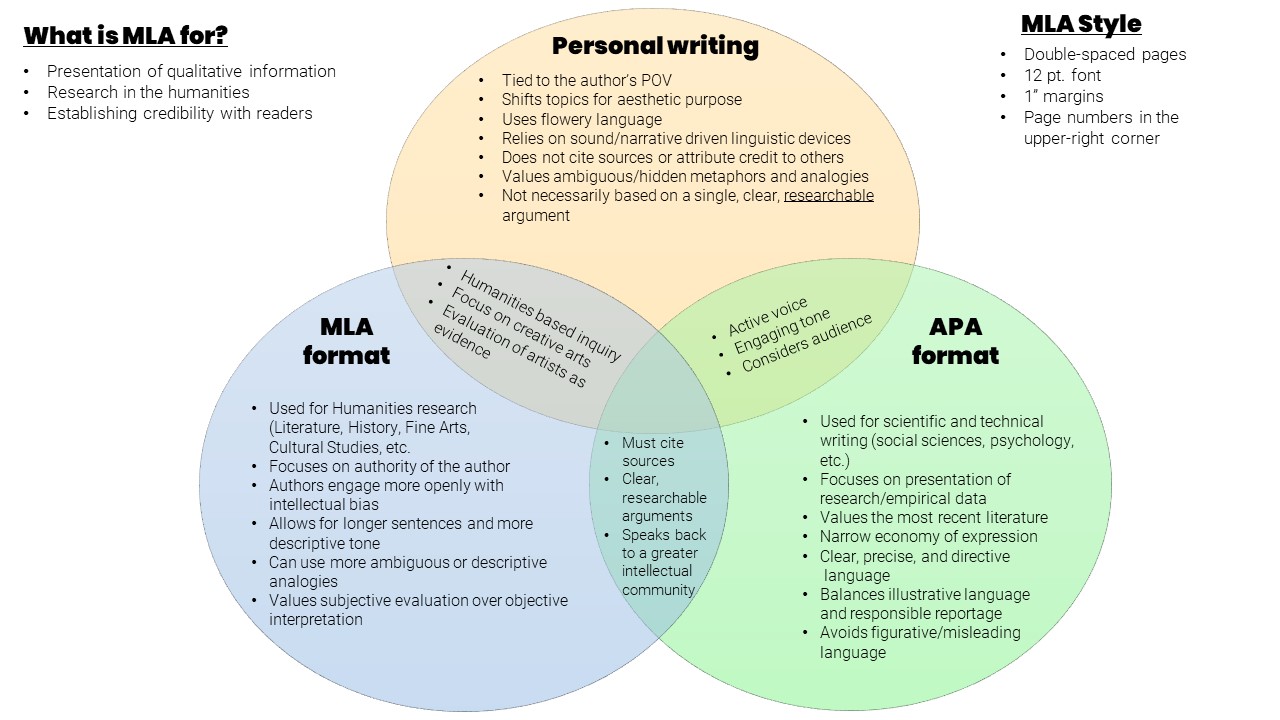MLA citations
A guide to formatting in MLA style
The basics
MLA is typically the preferred citation style for writers in the humanities. Citations and Works Cited entries in MLA prioritize the name and authority of the author.
When using MLA, remember the following:
- Use a signal phrase the first time you mention a source
- For in-text citations, include the author's name and page number(s), when known
- Organize your works cited page alphabetically
- When in doubt, cite your source!
In-text citations
Whether you've used a quote or a paraphrase, you must always cite your evidence. You can do this by using a parenthetical citation, aka an in-text citation. The way you format an in-text citation depends on the type of source and how the source appears on your Works Cited page.
Example 1: Writing is a process of discovery (Murray 1235).
Fun fact! If you've already mentioned the author's name in the sentence, you don't have to include their name again in the parenthetical citation.
Example 2: Peter Elbow and Pat Belanoff contend that research is a process of combining new and existing knowledge (303).
Don't know the author's name? Don't panic. Use the title of the work instead.
Example 3: Writing is a recursive process ("Resources for Writers: The Writing Process").
No page number? That can be the case for electronic sources. Just use the author's name or the title of the work.
Example 4: Search engines like Google have changed the way scholars find research (Grigas et al.).
Signal phrases
The first time you mention a source in your paper, you must include a signal phrase. A signal phrase includes a verb as well as the name of the author who wrote your source. If you do not know the name of the author, use the name of the organization that published the work you are citing.
Example 1: According to Kristine Johnson, there is a connection between writing and emotion (59-60).
Example 2: Michelle Navarre Cleary proposes ten reasons why students plagiarize (66-71).
Beware the citation generator!
We all know technology isn't perfect, so it's best to avoid relying on a citation generator for your Works Cited entries. Furthermore, the MLA updated their approach to citations in May 2016 and many citation generators have yet to catch up.
Moral of the story? Don't lose precious points to a technology fail!
Works Cited entries
Works Cited entries should include the following:
- Author's name
- Title(s)
- Editor(s), translator(s), illustrator(s), performer(s), and other contributors
- Volume, version, or edition
- Issue or number
- Publisher
- Publication date
- Location or page number(s) and DOI
- Access date (for sources accessed online)
Scholarly articles
Last name, First name. "Article Title." Journal Title in Italics and Title Case, volume, issue number, date of publication, location including page number(s) and DOI, if available. URL if accessed online and no DOI is available. Access date if accessed online.
Cohen, Michael. "Is Kermit the Frog in Trouble?" American Journal of Medical Genetics, vol. 104, no. 2, 2001, pp. 99-100, doi: 10.1002/ajmg.10001. Accessed 7 May 2019.
Work with three or more authors
Last name, First name, et. al. Book Title in Italics and Title Case, Publisher, year of publication.
Ambrose, Susan A., et. al. How Learning Works: Seven Research-Based Principals for Smart Teaching. Jossey-Bass, 2010.
Web page, author and date unknown
"Title of Web Page in Title Case."Website Title in Italics, URL. Access date.
"Kermit the Frog Puppet."Smithsonian National Museum of American History, https://americanhistory.si.edu/collections/search/object/nmah_765593. Accessed 7 May 2019.
Need more examples?
Check out the online Purdue OWL guide for a comprehensive list of MLA Works Cited and in-text citation examples.
